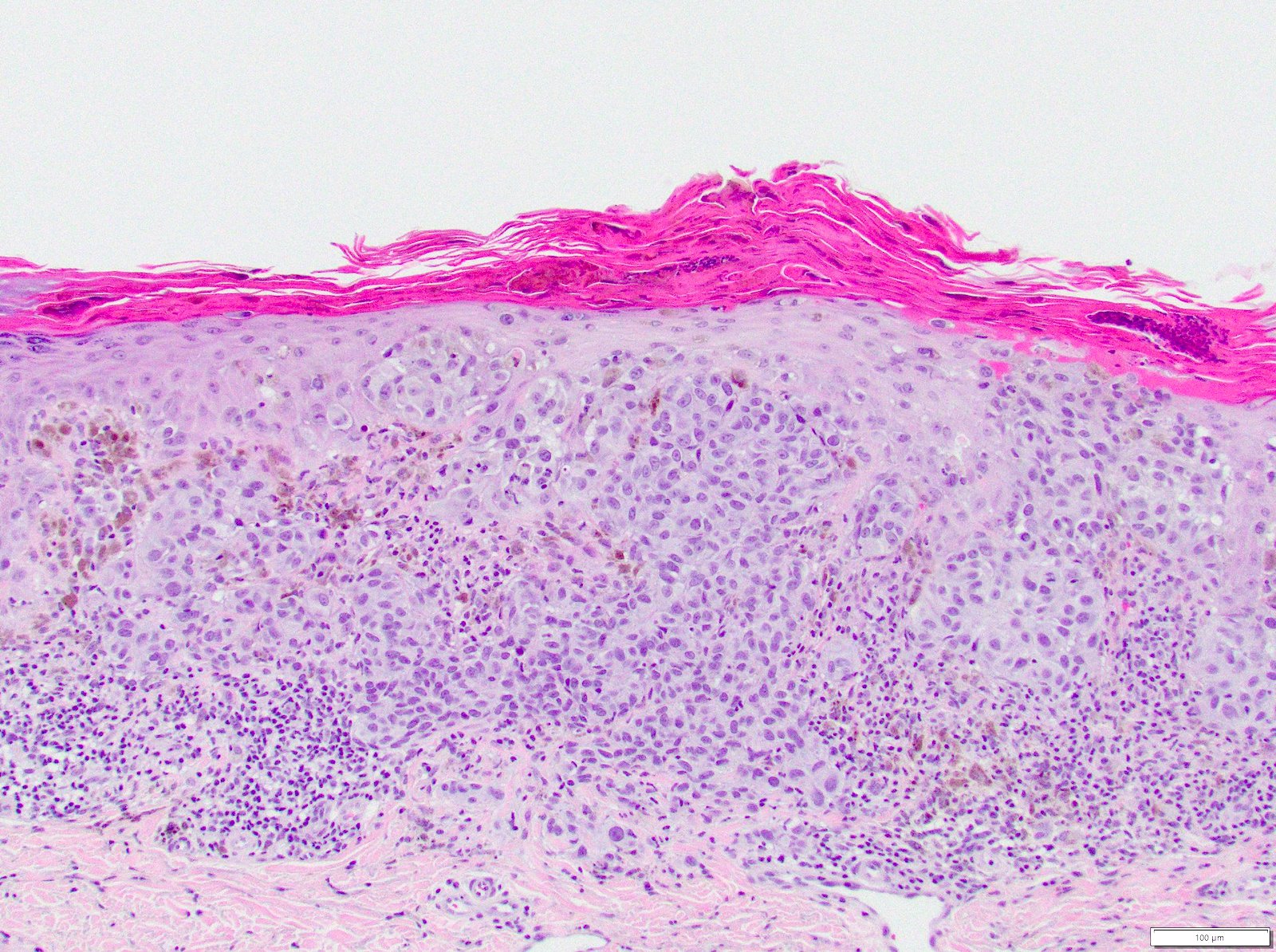Table of Contents
Definition / general | Essential features | Terminology | ICD coding | Epidemiology | Sites | Pathophysiology | Etiology | Clinical features | Diagnosis | Prognostic factors | Case reports | Treatment | Clinical images | Microscopic (histologic) description | Microscopic (histologic) images | Positive stains | Negative stains | Videos | Sample pathology report | Differential diagnosis | Additional references | Board review style question #1 | Board review style answer #1 | Board review style question #2 | Board review style answer #2 | Board review style question #3 | Board review style answer #3Cite this page: Rohr BR. Superficial spreading melanoma (low CSD melanoma). PathologyOutlines.com website. https://www.pathologyoutlines.com/topic/skintumormelanocyticsuperficialspreadingmelanomalowCSD.html. Accessed April 18th, 2024.
Definition / general
- Superficial spreading melanoma (SSM) is the most common subtype of melanoma in the Western world (Arch Pathol Lab Med 2020;144:500)
Essential features
- Develops on sun exposed sites with low cumulative sun damage (CSD) (Arch Pathol Lab Med 2020;144:500)
- Has a radial growth phase (Arch Pathol Lab Med 2020;144:500)
- Most common mutation in superficial spreading melanoma is BRAFV600E (Arch Pathol Lab Med 2020;144:500)
Terminology
- Pagetoid melanoma (Arch Pathol Lab Med 2020;144:500)
ICD coding
Epidemiology
- Superficial spreading melanoma accounts for up to 56% of cutaneous melanomas (Br J Dermatol 2021;185:700)
- Low cumulative sun damage (Arch Pathol Lab Med 2020;144:500)
- Intermittent sun exposure throughout childhood
- Tanning bed use
- Increased total number of melanocytic nevi (Arch Pathol Lab Med 2020;144:500)
- Dysplastic nevi (Arch Pathol Lab Med 2020;144:500)
- Increased size of nevi (Arch Pathol Lab Med 2020;144:500)
Sites
- Back in men (Arch Pathol Lab Med 2020;144:500)
- Legs, calves in women (Arch Pathol Lab Med 2020;144:500)
Pathophysiology
- Mutation patterns overlap with other melanoma subtypes
- Low CSD melanoma (Arch Pathol Lab Med 2020;144:500)
- Mutations (Arch Pathol Lab Med 2020;144:500)
- BRAF most common
- V600E most common amongst BRAF
- NRAS
- TERT
- Biallelic inactivation of CDKN2A
- PTEN, TP53 in advanced primary melanomas
- BRAF most common
Etiology
- Low cumulative sun damage (Arch Pathol Lab Med 2020;144:500)
- Intermittent sun exposure and sunburns
Clinical features
- Irregular red, brown or black macule, patch, papule or plaque (Arch Pathol Lab Med 2020;144:500)
- ABCDE: asymmetry, border irregularity, color variation, diameter > 6 mm, other evolution history
Diagnosis
- Excisional biopsy
- Histopathologic diagnosis is gold standard
- Sentinel lymph node biopsy (SLNB)
- For primary tumors with Breslow depth of 0.8 mm or deeper
- Consider SLNB if < 0.8 mm with ulceration
- Breslow depth: measured from the top of the granular layer or base of ulceration to the deepest invasive melanoma cell
- For primary tumors with Breslow depth of 0.8 mm or deeper
- References: Ital J Dermatol Venerol 2021;156:300, NCCN: NCCN Guidelines - Melanoma: Cutaneous [Accessed 3 October 2023]
Prognostic factors
- Adverse prognosis indicators (Ital J Dermatol Venerol 2021;156:300)
- Thicker (Breslow) depth: most important
- Presence of ulceration
- Dermal mitoses
- Deeper anatomic (Clark) level of invasion (I-V)
- Presence of lymphovascular invasion
- Presence of neurotropism
- Increased risk of local recurrence
- Presence of sentinel lymph node biopsy (SLNB)
- Positive excision margins
- Report proximity of melanoma in situ or invasive melanoma to excision margins when able
Case reports
- 32 year old man with primary superficial spreading melanoma recurring with desmoplastic melanoma features (Virchows Arch 2022;480:945)
- 47 year old woman with superficial spreading melanoma developing within a nevus spilus (J Osteopath Med 2023;123:223)
- 78 year old man with a history of superficial spreading melanoma developing a malignant peripheral nerve sheath tumor (World J Clin Cases 2021;9:6457)
Treatment
- Treatment includes excision with or without sentinel lymph node biopsy; additional treatment based on stage (NIH: Melanoma Treatment (PDQ®) - Health Professional Version [Accessed 7 July 2023], NCCN: NCCN Guidelines - Melanoma: Cutaneous [Accessed 3 October 2023], American Cancer Society: Immunotherapy for Melanoma Skin Cancer [Accessed 3 October 2023])
- Wide local excision 1 - 2 cm
- SLNB for primary tumors with Breslow depth of 0.8 mm or deeper
- Consider SLNB if < 0.8 mm with ulceration
- No clinical or radiographic evidence of nodal disease
- Targeted or immunotherapy / checkpoint inhibitors
- Targeted therapies include BRAF and MEK inhibitors
- Immune checkpoint inhibitors include PD1, PDL1, CTLA4 and LAG3 inhibitors
- Talimogene laherparepvec (T-VEC) injections
- Interleukin 2
- Chemotherapy
- Radiation therapy
- Regular skin examination with a dermatologist
Microscopic (histologic) description
- Radial growth phase with or without vertical growth phase (Arch Pathol Lab Med 2020;144:500)
- Large epithelioid melanocytes
- Prominent junctional and intraepidermal component
- Irregular and enlarged nests of melanocytes along dermal - epidermal junction
- Junctional melanocyte confluence
- Dermal component is composed of similar appearing melanocytes that fail to mature and disperse with descent; dermal mitoses are noted
- Pagetoid scatter
- Presence of melanocytes above the basal layer
- If invasive
- Failure of dermal melanocytes to mature (i.e., become smaller) and disperse (i.e., smaller nests, single unit melanocytes) with descent into the dermis
- With or without dermal mitotic figures
- With or without melanin pigmentation
- Absent to moderate underlying solar elastosis
- Lacks severe solar elastosis
- Precursor or associated melanocytic nevus may be present (Arch Dermatol 2003;139:1620)
- Most frequent melanoma subtype to arise with a nevus
- Pathologic stage classification AJCC guidelines, eighth edition (2018) (Ital J Dermatol Venerol 2021;156:300)
- Tumor (Breslow) depth is the strongest predictor of clinical outcome, used for staging
- Measure vertically from the top of granular layer of the epidermis to the deepest invasive melanoma cells
- If ulcerated, measure from base of ulcer
- Round to nearest 0.1 mm using ocular micrometer
- Avoid measuring vascular invasion, microsatellites, involvement of skin appendages
- Tumor (Breslow) depth is the strongest predictor of clinical outcome, used for staging
Microscopic (histologic) images
Positive stains
- SOX10 (nuclear)
- MART1, also known as MelanA (cytoplasmic)
- PRAME
- HMB45
- S100
- MITF
- Tyrosinase
- BRAF variable
- Reference: Semin Diagn Pathol 2022;39:239
Negative stains
- Loss of melanocytic markers is possible (Dermatopathology (Basel) 2021;8:359)
- Keratin immunostains
- CK, AE1 / AE3, OSCAR, CAM5.2
- Rare aberrant expression in melanoma (Dermatopathology (Basel) 2021;8:359)
- Neuroendocrine markers
- Neurofilament, glial fibrillary acidic protein, synaptophysin, chromogranin, CD56
- Rare aberrant expression in melanoma (Dermatopathology (Basel) 2021;8:359)
- Muscle specific markers
- Macrophage markers
- CD68, CD163
- Rare aberrant expression in melanoma (Dermatopathology (Basel) 2021;8:359)
- Vascular markers
- CD31, CD34
- Rare aberrant expression in melanoma (Dermatopathology (Basel) 2021;8:359)
- Hematopoietic markers
- CD4, CD20
- Rare aberrant expression in melanoma (Dermatopathology (Basel) 2021;8:359)
- Miscellaneous
- FLI1, GATA3, CEA, calretinin, PAX8, PAX2
- Rare aberrant expression in melanoma (Dermatopathology (Basel) 2021;8:359)
Videos
Superficial spreading melanoma
by Dr. Jerad Gardner
Sample pathology report
- Skin, biopsy:
- Invasive malignant melanoma, superficial spreading subtype, extending to a Breslow depth of ## (see comment)
- Comment: The sections reveal a severely atypical compound melanocytic proliferation composed of atypical epithelioid melanocytes. The melanocytes are poorly nested along the dermal - epidermal junction with confluence and pagetoid scatter. The dermal component is composed of similar appearing melanocytes that fail to mature and disperse with descent. Dermal mitoses are noted.
Differential diagnosis
- Lentigo maligna melanoma:
- High cumulative sun damage
- Significant dermal solar elastosis
- Pagetoid scatter is less prominent
- Radial growth phase
- More common on chronically sun exposed sites of elderly, light skinned adults
- High cumulative sun damage
- Acral lentiginous melanoma:
- Acral sites
- Noncumulative sun damage related
- Nevoid melanoma (Ital J Dermatol Venerol 2021;156:300):
- Resembles intradermal nevus, 2 types
- Papillomatous type
- NRAS mutation most common
- Head, neck, limbs
- Puffy shirt appearance: scanning magnification shows dense cellular aggregates surrounded by bent elongated rete ridges lined up side by side
- Maturing nevoid type: limbs, trunk
- Heterogeneous mutations: BRAF, NRAS
- Nodular melanoma:
- Low or high cumulative sun damage
- No radial growth phase
- Cutaneous involvement of metastatic malignant melanoma:
- History of prior locoregional invasive melanoma
- Features that favor metastases (Arch Pathol Lab Med 2020;144:500)
- Tumor size of < 2 mm
- Absence of tumor infiltrating lymphocytes and plasma cells
- Monomorphism
- Involvement of adnexal epithelium
Additional references
Board review style question #1
Board review style answer #1
A. BRAF is the most commonly mutated driver oncogene in low cumulative sun damage melanoma. The most common mutation is the p. V600E. Answers B - E are incorrect because NRAS, TERT, PTEN and TP53 are less commonly mutated in superficial spreading melanoma.
Comment Here
Reference: Superficial spreading melanoma (low CSD melanoma)
Comment Here
Reference: Superficial spreading melanoma (low CSD melanoma)
Board review style question #2
From which of the following pathways does superficial spreading melanoma develop?
- Both high and low cumulative sun damage
- High cumulative sun damage
- Low cumulative sun damage
- No association with cumulative sun damage
Board review style answer #2
C. Low cumulative sun damage. Superficial spreading melanoma arises on sun exposed skin sites with little underlying solar elastosis. Answer B is incorrect since high cumulative sun damage is associated with lentigo maligna melanoma. Answer D is incorrect since superficial melanoma is associated with low cumulative sun damage. Answer A is incorrect because nodular melanoma may be associated with both high and low cumulative sun damage.
Comment Here
Reference: Superficial spreading melanoma (low CSD melanoma)
Comment Here
Reference: Superficial spreading melanoma (low CSD melanoma)
Board review style question #3
Which subtype of melanoma is most likely to arise in association with a precursor melanocytic nevus?
- Acral lentiginous
- Lentigo maligna
- Nodular
- Primary dermal
- Superficial spreading
Board review style answer #3
E. Superficial spreading melanoma is the most frequent histologic subtype of melanoma to be found arising in association with a melanocytic nevus. Other predictors of melanoma arising in association with a nevus include younger age and truncal location (Arch Dermatol 2003;139:1620). Answers A - D are incorrect because these other melanoma subtypes are less commonly documented to arise in association with a precursor melanocytic nevus.
Comment Here
Reference: Superficial spreading melanoma (low CSD melanoma)
Comment Here
Reference: Superficial spreading melanoma (low CSD melanoma)














